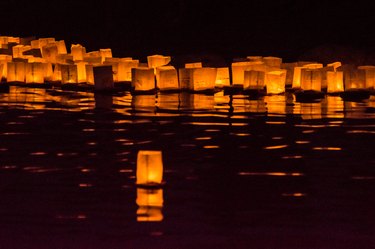
Holiday luminaries, or luminarias, are sand-filled paper bags with light bulbs, votive candles, flameless battery-operated tea light candles or even battery-powered LED tea lights or LED candles set inside—nearly any small source of warm white light works well. Luminarias line the streets, walkways and rooftops in the Southwest United States and throughout Mexico and Latin America during the nine days before Christmas, often through the new year into January 6, for the Feast of the Three Kings during the holiday season. The lights show the way to the Inn for Mary and Joseph during Las Posadas. These holiday decorations are also called farolitos, which means little lanterns.
History of Luminara
Video of the Day
The early versions of luminary lights were not made out of paper. The U.S. Department of the Interior National Park Service notes that the first lanterns were actually crisscrossed pinon branches built into 3-foot-high squares. The bonfires were lit to guide people to Midnight Mass on Christmas Eve. Las Posadas is a nine-day celebration of the journey of Mary and Joseph to Bethlehem, and their difficulty finding lodging when they arrived.
Video of the Day
Children carry farolitos from house to house, accompanying "Mary" and "Joseph." They knock on doors, sing a song begging for food and shelter, and are turned away. At the last house of the evening, which is designated as La Posada, or the resting place, the children (and adults) are invited inside and served holiday tamales, biscochitos, posole and chili stews.
Making DIY Luminaria Bags
Holiday luminaries, or farolitos, can be made from small paper bags. Use white bakery bags for the most dramatic effect. The paper allows the glow of the candle or multi-color LED lights inside to show. Consider flame resistant light sources for luminaries intended for children. Colored bags are available in grocery stores, close to the plain brown paper lunch bags in the household products aisle.
Fold the top two or three inches of the bag down. If desired, cut a Christmas tree, star, holly leaf or other Christmas decoration shapes into the side of the bag. This creates an interesting effect as the candle flickers inside. Fill the bag halfway with sand, then push the candle down into the sand about an inch. The sand keeps the bag from being blown over, and prevents the melting candle wax from accidentally setting the bag on fire.
Global Luminaria Influences
According to the AZ Central website, the festival of Las Posadas originated when Catholic missionaries introduced the story of Mary and Joseph and the birth of Jesus to the native people of Mexico and and Latin America. Because wood is often scarce in the Southwest, the practice of lighting signal bonfires was not sustainable. When Chinese immigrants brought their beautiful paper lanterns with them, locals began using them instead of lighting bonfires. The lanterns were expensive and the paper to make them was scarce, so people began using plain paper bags instead.
Significance of Luminaria
Cities such as Albuquerque, New Mexico have become famous for their holiday luminary displays. Neighborhoods and charities all over the country use the sale of holiday luminaria supplies as a fundraiser, often netting several thousand dollars a season. Displays of holiday luminaria generate several million dollars from tourism to many Southwest towns. This money is a vital resource for these communities.
Cleanup and Recycling
Unlike jack-o-lantern Halloween decorations, there is little cleanup with luminarias. Remove the spent luminary candle, which can sometimes be re-melted and molded again. If you used string lights or Christmas lights simply reuse them, possibly as night lights. Pour the sand into a covered container with a tight lid to keep cats and other animals from fouling it between seasons.
Fold the paper luminary bags and store them if they are in good shape. If they are tattered or scorched too much to use for home decor, they can be shredded and added to your home compost pile.